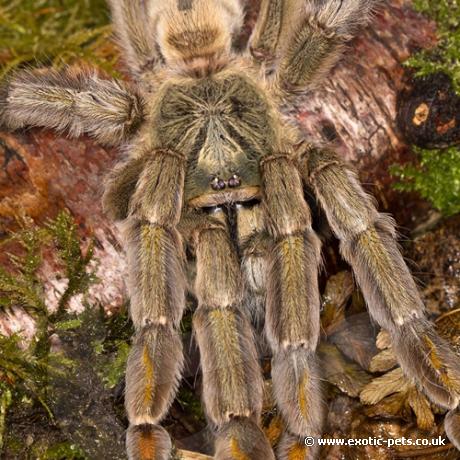

The Trinidad Chevron Tarantula is a fast growing species reaching a leg span of six inches. They are arboreal spinning a web within loose tree bark or plants.
This arboreal Tarantula has now become a very popular species within the hobby. These spiders have an overall olive brown and fuzzy looking appearance, but they do have some very distinctive features. They have dark chevron markings on the abdomen (of which this species gets its name) but they also have stunning bright orange markings on the Tarsus, Metatarsus leg joints. This species get to a size of around 6-7 inches in our experience, and can mature from a small spiderling to fully grown within 18-24 months.
They are found in tropical areas of Trinidad & Tobago generally at the base or near the bottom of trees. They will generally lay a lot of thick webbing as adults, and conceal themselves away.
Spiderlings – These are quite straight forward to keep when young, but you must follow some simple rules to keep them alive! It is best to keep them in a small pot or jar but you must provide plenty of ventilation for these spiderlings whether this is by using drilled holes or some sort of meshing. These spiders are generally pigs when it comes to feeding time and they will very rarely refuse a meal. You should aim to keep these spiders between 75f – 85f but they cannot be allowed to dry out, for substrate we would recommend coir or peat moss. These types of setup require a regular light misting to prevent drying out, but don’t saturate them in water either as this will attract problems such as mould growth etc. Spiderlings should be fed every 4-7 days on a couple of small crickets or equivalent.
Adults – Provide them with an arboreal style setup with a leaning piece of cork bark buried half in the substrate. You will find the spider will then use this to build itself a home, webbing frantically all over the tank. Give a light misting occasionally and again not letting the enclosure dry out for long periods of time. Feed your chevron adults every 10-14 days on a couple of adult crickets.